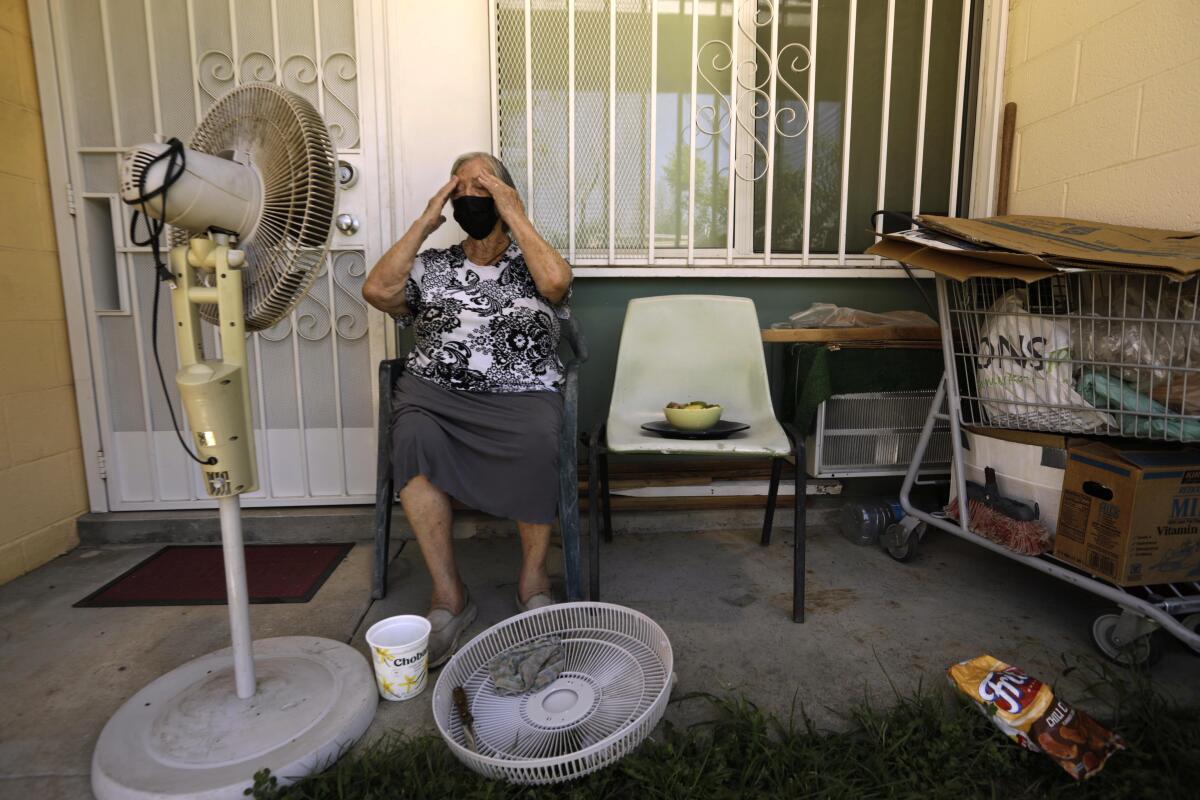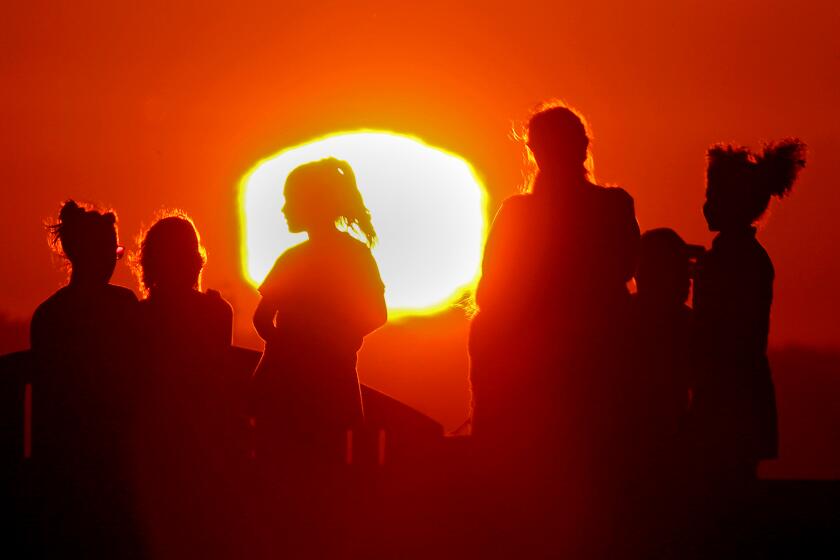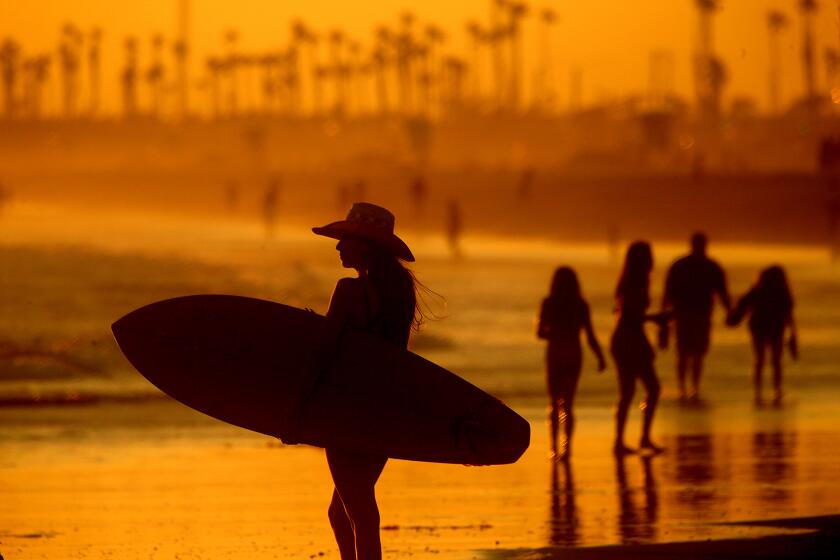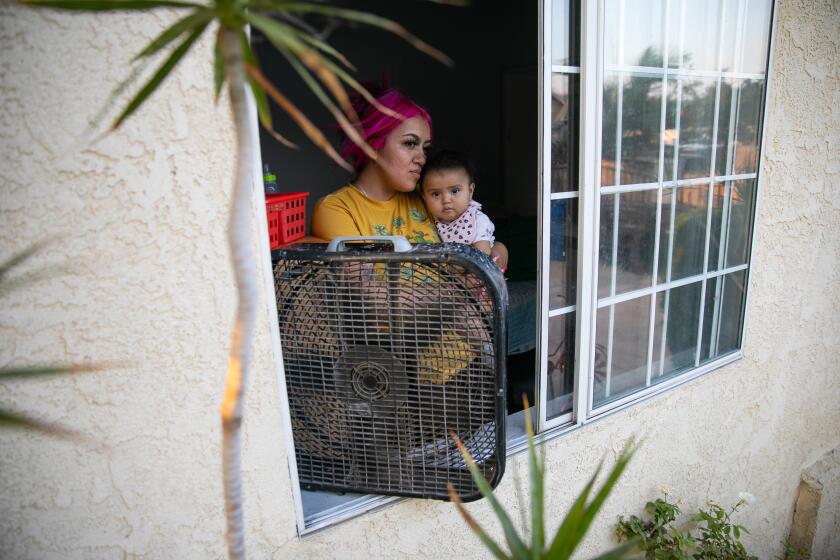How to cool off without air conditioning

- Share via
This winter felt like it lasted a thousand years and ended approximately two weeks ago. Now, it seems we’ve skipped spring entirely and jumped straight into punishing summer heat.
Los Angeles is experiencing its second heat wave of the month this week, with temperatures reaching the 70s to mid-80s on the coast and triple digits inland. An excessive heat warning has been issued for the Apple and Lucerne valleys through Sunday at 8 p.m. The Antelope Valley and foothills are under excessive-heat warnings from 10 a.m. Friday through 10 a.m. Monday. The valleys, the San Fernando Valley foothills and the L.A. County mountains are expected to bear the brunt of the “heat dome”; Woodland Hills could see temperatures as high as 107 on Saturday.
Is this normal? No.
Why is this happening? Climate change.
The hottest day in recorded human history occurred this month — a record promptly defeated the next day. L.A. broke its heat records in multiple areas just last year. Experts expect California to be hotter than average this summer. Last year’s record-breaking heat may have been one of the coolest summers of the rest of our lives. Climate change is man-made and researchers from 67 countries are urging action to address its imminent threats.
California has earmarked $800 million for projects to cool schools and neighborhoods and reduce urban overheating; L.A. is exploring making air conditioning mandatory in all rental units. The L.A. Department of Water and Power is offering $225 rebates on portable and window A/C units to customers enrolled in certain discount rate programs.
If you have air conditioning, this would be a good time to consider running it. If you don’t — or if you’re trying to keep your electric bill down, or just reduce your reliance on fossil fuels for electricity — here are some tips for beating the heat without AC.
The National Oceanic and Atmospheric Administration predicts that California temperatures in June, July and August will be warmer than normal.
Unplug unused electronics and avoid using appliances
Hover your hand over a plug in an outlet. You’ll probably feel some warmth. Everything that’s plugged in and running generates a small amount of heat, even your phone charger. Unplug or at least turn off anything you’re not using.
Appliances, whether gas-powered or electric, also generate heat. Avoid running the dishwasher or laundry machine or using the stove or oven until nighttime.
Stay hydrated and eat cooling foods
However much water you’re drinking now, drink more of it. The traditional advice to get eight eight-ounce glasses per day is considered outdated; the Mayo Clinic says to shoot for around 90 ounces a day for women and 125 for men. It doesn’t have to be just water: Tea, milk and other beverages low in sugar and caffeine will count toward your total, as will water-rich fruits and veggies like watermelon and spinach. Even coffee and caffeinated sodas are considered OK in moderation. If you’re sweating a lot, up your intake even more. Your urine should be “the color of light lemon juice,” per the Washington Post.
The Centers for Disease Control and Prevention recommends avoiding energy drinks and alcohol when you’re dealing with high heat. Both can make you urinate more.
And big meals will heat up your core while your body works to digest them. There’s never been a better time to try out some no-cook dinners.
Popsicles and ice cream are good hot-weather treats, but hydrating fruits and vegetables will cool you down more in the long run.
A heat wave baking Southern California could bring dangerous, record-setting temperatures to inland and desert areas.
Cover windows and close off unused rooms
During the day, when the sun’s beating down, keep your curtains closed. If you have some rooms that tend to heat up more than others, close the doors to keep the hot air from getting into the rest of the house.
Make the most of your fans
A lot of people just point their fan at themselves. The evaporation makes you feel cooler, but doesn’t lower your body temperature. If it’s above 99 degrees where you are, pointing a fan at yourself may do more harm than good. Fans don’t cool your body or the air temperature on their own. But they are efficient at exhausting hot air out and spreading cooler air around.
If you want to bring down the temperature of a room, point a fan facing out of a window to blow out the hot air, and use another fan to blow cooler air in from another window or a less-hot part of the house.
You can stick a baking sheet of ice or frozen water bottles with a damp cloth on them in front of a fan to make the air feel cooler. (While you’re putting things in your freezer, some damp towels for the back of your neck and even your bedsheets are good candidates for a brief visit.)
There are a few different ways to create a cooling cross-breeze in your house. If your room has two windows that face each other, open both of them and close all the other windows. Put a fan blowing inward in front of one and outward in front of the other for an added effect. If your room has only one window, create a cross breeze by pointing a fan at it from across the room. In all of these scenarios, remove any objects between the fans and windows.
If you’re running your A/C but want to cool down the house faster, position a fan in front of where the cool air is emanating to disperse it faster.
Do you have a ceiling fan? Make sure the blades are running counterclockwise for a cooling effect. (In the winter, you can reverse the direction to help move warm air.)
Fans won’t work as efficiently if they’re caked with dust. When was the last time you cleaned yours? Once it’s cool enough to turn them off, give the blades a wipe down, and wipe or vacuum out the casing.
The Los Angeles Department of Water and Power has relaunched a rebate program for energy-efficient air conditioners to help lower-income Angelenos stay cool.
Visit a cooling center or a pool
If you’ve tried everything here and you still can’t cool down, Los Angeles County has more than 150 free cooling centers. Here’s a map of where to find them. Public libraries, shopping malls, community centers, and grocery stores also offer air-conditioned relief.
Public pools are another great place to cool off, though lifeguard staffing issues may have changed your local pool’s hours. Here are the summer 2023 L.A. County public pool locations and hours.
Know when to seek medical help
Heat exhaustion and heatstroke are potentially deadly heat-related illnesses. If you experience any of the following symptoms, immediately call 911.
Heat exhaustion: An internal body temperature of more than 104 degrees, lethargy, dizziness, inability to communicate, headache, a dip in cognitive abilities, fainting and profuse sweating.
Heatstroke: An internal body temperature of more than 104 degrees, loss of consciousness and possibly dry skin. Lack of sweat because your natural cooling system is compromised.
About The Times Utility Journalism Team
This article is from The Times’ Utility Journalism Team. Our mission is to be essential to the lives of Southern Californians by publishing information that solves problems, answers questions and helps with decision making. We serve audiences in and around Los Angeles — including current Times subscribers and diverse communities that haven’t historically had their needs met by our coverage.
How can we be useful to you and your community? Email utility (at) latimes.com or one of our journalists: Jon Healey, Ada Tseng, Jessica Roy and Karen Garcia.










